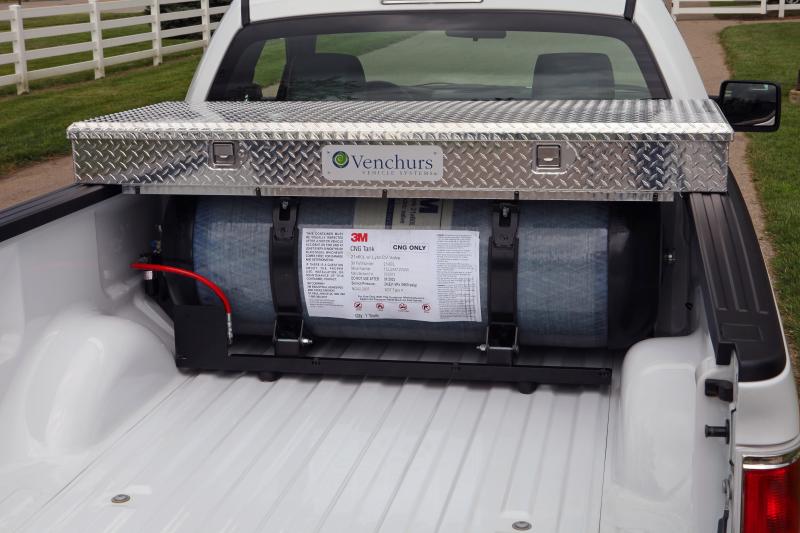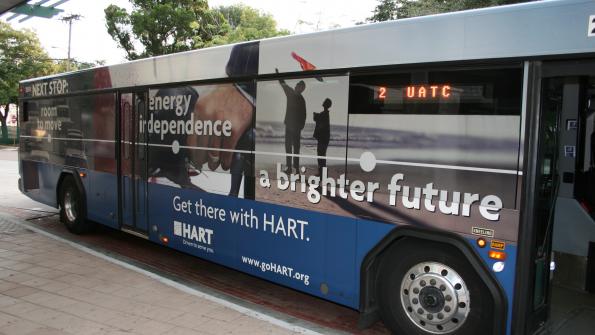In it for the long haul
What is in this article?
In it for the long haul
Why did several Oklahoma agencies recently order more than 321 bi-fuel pickups that operate on both gasoline and compressed natural gas (CNG)? And, why is Hillsborough County, Fla., switching much of its fleets to CNG?
Simple: Natural gas costs less than gasoline. And, as both Oklahoma and Hillsborough County plan an ever-widening network of natural gas refueling stations, reaping fleet savings is getting easier.
While CNG is cheaper, a bi-fuel vehicle costs more. For example, a 2014 Ford F-150 fitted with a factory-installed gaseous-fuel prep package for a standard 3.7-liter V6 that can run on CNG or liquefied petroleum gas (LPG or propane) costs an extra $315. The full “alternative fuel” package – including fuel tanks, fuel lines and CNG/propane-capable fuel injectors – adds an extra $6,000 to $9,500 to such pickups, depending on tank capacity.
Natural gas prices more stable than gasoline
 Yet, because natural gas prices have stabilized in recent years, such CNG conversions can provide a more steady and reliable cost savings over time, says Joshua Bull, sector head of the San Francisco-based research firm FC Gas Intelligence.
Yet, because natural gas prices have stabilized in recent years, such CNG conversions can provide a more steady and reliable cost savings over time, says Joshua Bull, sector head of the San Francisco-based research firm FC Gas Intelligence.
“Over the last decade, NG prices have dropped dramatically as new North American sources of supply have opened up, with the United States moving from a potential NG importer to a potential significant NG exporter over this time period,” Bull says.
Oil prices have been especially volatile over the same time. Since 2000, FC Gas says refined diesel prices as measured by Diesel Gallon Equivalents (DGEs) have always exceeded NG prices, sometimes by as much as $2, but usually by at least $1.50, per DGE. Similarly, gasoline prices have always exceeded NG prices when measured by Gasoline Gallon Equivalents (GGEs), by as much as $1.50 per unit.
“NG prices also have another advantage for planning purposes in that they have in recent years traded in a much narrower band than either diesel or gasoline prices, with the prices varying since 2000 about $1 from lowest to highest price,” Bull says.
Since late 2004, this price spread has been even tighter, varying by no more than 75 cents, he says. NG prices have not always traded in such a narrow band, and in fact, until technology increased the domestically produced supply, NG prices had been among the most volatile commodities traded on the New York Mercantile Exchange (NYMEX), Bull notes.
“Future forecasts of NG supply suggest that future volatility will follow the recent pattern of tighter trading spreads,” he says.
Lower fuel cost driving conversion
The Lower Merion School District in Ardmore, Pa., received a Pennsylvania alternative fuels incentive grant (AFIG) in 2009 to help finance buying nine new CNG-fired buses, according to a Pittsburgh-based Allegheny Conference on Community Development (ACCD) study.
Each bus cost $46,000 but, at the time, CNG was only 62 cents cheaper than diesel, so the fuel savings per bus per year was less than $1,600. That meant the school district would have recouped less than half the additional cost of the bus over the vehicle’s expected 10- to 12-year life span.
But things changed considerably in 2010, the ACCD’s research found, when Lower Merion applied for another AFIG grant from the state. In just one year, the equipment differential had shrunk so that a CNG bus was only $30,000 more than its diesel counterpart, while the pricing spread between CNG and diesel increased to $1.27. Under those conditions, the buses would be paid off in less than 10 years, the group found.
Thus, falling equipment costs combined with greater value from fuel savings made it easier for government fleets to consider switching to natural gas fuels.
For example, by last September, the U.S. Department of Energy (DOE) estimated that roughly 112,000 natural gas vehicles (NGV)s operate in the U.S., with transit buses currently forming the largest CNG- or LNG-powered category. Half of waste collection vehicles are fueled by CNG, making it the second largest category of NGVs followed by airports, with about 35 using NGVs, either by operating their own fleets or promoting using private fleets that burn NG.
Florida-based Hillsborough Area Regional Transit Authority (HART) is trying to capitalize on the lower cost of NG prices by buying buses and vans that operate on CNG and by installing a CNG filling station in partnership with Newport Beach, Calif.-based Clean Energy.
That fueling station – going online this year – will be equipped with four CNG dispensers to fuel buses, vans and other fleet vehicles, with the capability to be upgraded with compressors as the HART fleet – which serves 14.6 million people – gradually transitions its entire fleet to CNG buses.
“We expect our new natural gas vehicles to allow people to continue to commute in comfort and at the same time improve our air quality,” says Katharine Eagan, HART’s interim chief executive officer. “Natural gas is available domestically and at this time, costs approximately 20 percent to 25 percent less than diesel.”
She adds that HART plans to deploy 28 new CNG vans to replace its diesel-powered models, and by early next year expects to put 22 new CNG buses on the road as diesel models are retired from service. By the end of 2015, HART expects a total of 59 CNG vehicles to be in service.
Clean Energy estimates HART’s new natural gas-fired fleet will consume approximately 230,000 DGEs of CNG in year-one of operation and approximately 725,000 DGEs annually by 2018. Considering fuel pricing trends and comparable maintenance costs should help HART cut its fuel and operating costs, according to the vendor.
Saving on fuel expenses is one of the main reasons why Pomona, Calif., decided to swap out its entire 20-vehicle fleet of refuse trucks with low entry side-loaders and two rear-loading vehicles – all built by Mack Trucks and all equipped with 320-horsepower Cummins Westport ISL G CNG-fired engines.
Howard Morris, Pomona’s solid waste manager, says the South Coast Air Quality Management District forbids purchasing diesel trucks in its part of the state, so the city could either retrofit existing trucks with natural gas engines or buy new vehicles that run on the fuel, he says.
Still, Morris says the air-quality mandate changed the city’s operation in two ways: the trucks are quieter and they save money on fuel. “It’s $2-plus per 1,000 cubic feet [million BTUs] of natural gas and diesel is bouncing around $4 a gallon. We haven’t had the trucks in service for a full year but I know we’re going to save money on fuel,” he says.
The ability to generate long-term savings also convinced Grand Junction, Colo., to start switching to CNG for its heavier trucks in 2009. According to a case study compiled by the Colorado Energy Office, Grand Junction initially converted seven vehicles to CNG and found that in one year of operation (May 2011 through April 2012) they were able to reduce fuel consumption by 34,150 DGEs.
Grand Junction also obtained federal grants (largely from the Department of Energy) and private investment to construct a $1.35 million natural gas refueling depot, with the city chipping in 18 percent of that cost, or $240,457. The CNG refuse trucks cost $268,155 per unit – which is $167,187 more than four comparable diesel-powered refuse units, or $41,766 per unit.
The city estimates it will save $40,000 per year in fuel costs with those seven units – savings enough to pay for the city’s extra upfront investment in the trucks and in its refueling depot within 10 years. Jay Valentine, financial operations manager for Grand Junction, says the cost savings were “the dominant factor” in considering the switch to CNG.
















